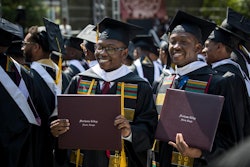In post-mortems throughout political America, pollsters are being taken to task for getting a lot of what happened on Election Day wrong. And that’s just in figuring out the White vote.
If they couldn’t figure out why Democratic candidates were more competitive than first thought, maybe it’s because pollsters still don’t know how to deal with people of color.
You can’t go scoop up a random sample of a 1,000 or so voters and hope to get a representative sampling. You’ll miss some. Actually, you’ll miss a lot.
So pollsters didn’t see the tight race in Virginia with Democratic Senator Mark Warner edging out Republican Ed Gillespie. Nor could they say what the real difference maker was.
People lying about their civic engagement and not turning out? How about lousy polling methods for diversity?
The Warner race really makes the case for a more diverse sample.
For example, Asian Americans are rarely included in big enough numbers in most mainstream polls, and generally rate an “Insufficient.”
That’s just another word for “invisible.”
When you’re rendered invisible, then the word spreads. Politicos rely on these polls to prepare strategy and outreach.
And then guess who gets left out of the process?
What to do?
Adopt the methods that some nonprofit groups are already using like the targeted oversampling of specific communities. That approach augments polling samples and assures inclusion. It also means conducting polls in multiethnic languages. The Asian American Legal Defense and Education Fund has conducted exit polls in every major election since 1988 in up to 12 different languages: Chinese, Korean, Vietnamese, Tagalog, Khmer, Arabic, Bengali, Hindi, Punjabi, Urdu, Gujarati and English.
This year, the 2014 AALDEF Asian American Exit Poll examined voting patterns of Asian Americans in 11 states with large or fast-growing Asian American populations: New York, New Jersey, Massachusetts, Pennsylvania, Virginia, Maryland, Michigan, Texas, Georgia, Louisiana, Nevada and Washington, D.C. For the midterm elections, 4,200 voters were polled. In the 2012 presidential election, AALDEF polled 9,096 Asian American voters in 14 states.
The Virginia race found that Asian Americans were solidly behind Warner, 66 percent; Gillespie, 33 percent.
It’s a significant finding because the much wider margin of victory among Asians is larger than the actual margin of .5 percent.
It’s a similar finding made by the Asian American Decisions/AAPI Civic Engagement Fund election eve poll finding in Virginia.
To pollsters, the Asian American margin in the Warner race is indicative of a real swing vote, and a powerful sign of real Asian American political power.
But all that would be lost simply because mainstream pollsters don’t bother to find Asian Americans.
As the electorate becomes less White, and more diverse, pollsters will have to adopt better methods to make sure they aren’t blinded to what’s really happening at the polls.
Emil Guillermo writes on issues of race, culture and politics for the Asian American Legal Defense and Education Fund (www.aaldef.org/blog). Like him at www.facebook.com/emilguillermo.media and on Twitter @emilamok.



















